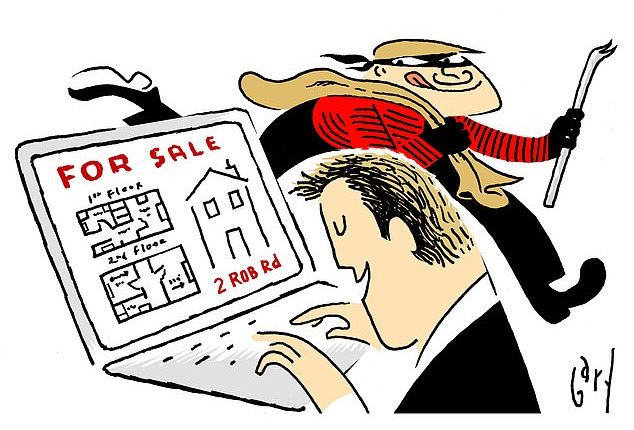
An armchair house-hunting revolution is under way. Gone are the days when searching for a new home meant an energy-sapping trudge around various estate agents only to find at the viewing that the property didn’t live up to expectations.
And the trend continues, with most potential buyers now starting the search for their perfect home on the internet.
It’s beneficial to the vendor, too. The access to potential purchasers is much wider. So, if you are marketing your property online, you’ll want to offer as much visual detail and information as possible.
But while multi-angle photos of your newly decorated sun lounge may get things moving, unfortunately there’s also a darker side to dishing up such forensic detail of your home.


Detailed: Canny criminals can use simple online tools and easy access intelligence to help plan a break-in
Principally that it gifts canny criminals with simple online tools and easy access intelligence to help plan a break-in.
‘This kind of information gives the burglar time to plan their crime, giving them those vital minutes to get in, rob your home, and make a clean getaway,’ says Mark Hall of rubbish removal company divert.co.uk.
‘And coupled with Google Street View, they’ve probably already got a good idea of access points and CCTV blind spots.’
A floor plan, for example, could offer detailed directions of how a crook should proceed once they’ve broken into the house. A walk-through video can unwittingly offer guidance as to whether the burglar could be seen from the street.
Break-ins are on the increase, with new data from Statista revealing there were more than 279,000 burglaries in England and Wales last year alone.
Plus, recent analysis revealed no break-ins were resolved in 48.2 per cent of neighbourhoods across England and Wales in the three years to March 2023.
And since the majority of home searches are now done online — either through individual agencies or dedicated websites such as Zoopla — the prospect of rich pickings for the resourceful robber is huge.
Of course, a burglary is a horrible and traumatic experience since it represents a violation of the one place you should feel safe. But a break-in can also have a catastrophic impact on the sale of the property, too.
Potential buyers may pull out as it gives the impression that they will be living in a crime hot spot.
Or the vendors may be unable to move on to their next buy if expensive repairs are needed after the break-in.
So how can you market your home effectively without offering its contents to an opportunistic thief?
Remember, says Mark Hall, that you’re in total control of what the public gets to see when selling your home online, no matter what pushy estate agents might tell you.
So make sure, he says, that any photographs that show a room’s layout are generic views.
‘If you have a problem with any of the images they produce, then reject them,’ says Mr Hall. ‘It’s your house, your privacy, your security, and totally your decision.’
Property fraud expert Colum Smith, from law firm Taylor Rose MW points out that empty homes are particularly susceptible to a break-in.
He says: ‘I’d avoid putting pictures up online of a property which you can clearly see is not being lived in. Criminals scour the internet for details of empty properties which are on the market and then try to use those details to carry out fraud.
‘Signing up to the Land Registry’s free property alert service means you will receive an email if anyone attempts to deal with your property title.’
He adds that 3D tours should be considered carefully, too.
‘These can be a great tool for criminals. It allows them to download and replay frames of the tour. They could also potentially zoom in on specific areas of your home that might be vulnerable or of interest to them.’
However, if you do want to go ahead with a virtual tour, Javvad Malik, lead security awareness advocate at KnowBe4, suggests scrutinising any video before posting it online.
‘Look at what personal information is available to see and either move it or obscure it before posting online.
‘Many times, letters are visible that have homeowner details on it. Family photos, location of house keys, and car registration details can all provide information that can be used by criminals looking to profile the house or occupants.’
This even means making sure that no keys are photographed. ‘With high resolution pictures, it is even possible to duplicate keys from just a photo,’ he adds.
Of course, there’s nothing wrong with generic pictures that give a broad feel for the dimensions of your home. But Sumier Foster-Shah, product support manager of locksmiths ERA, says that it’s vital to keep anything worth stealing out of sight.
‘Valuables, such as electronic goods, wallets, jewellery, and other expensive items should all be kept in closed cupboards or drawers, rather than out in the open where they can be easily seen.
‘When it comes to particularly expensive items and other important personal possessions, a small safe is recommended for the highest levels of security.’
The internet remains an effective way to sell your home. Just make sure that the invitation to view isn’t more welcoming than you’d like it to be.










